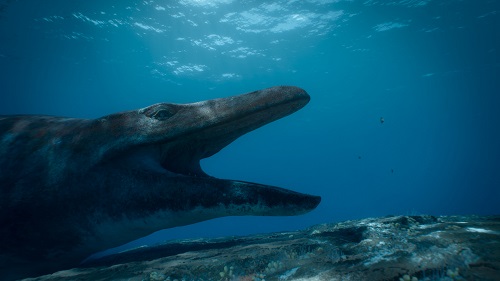Written by Jack Alger, HMNS Paleontology Intern

Jack Alger, HMNS Paleontology Intern
This summer I bring dimetrodons back to life.
No, life has not found a way, I’m not extracting DNA from inclusions found in amber; I work in the Houston Museum of Natural Science in Sugar Land. It’s a small brick building with a splendid collection of history both recent and prehistoric whose residents stand 30 feet tall and have razor sharp teeth.
Every weekday from 9 in the morning to 1 in the afternoon I sit behind a large table, stare through a lit magnifying glass, and with implements of dentistry I carefully extract the bones of Diego, a 280 million year old dimetrodon, from the hard north Texas rock.

I am an exhibit.
Visitors of the museum who meander all the way back to the Paleozoic section have the opportunity to watch me work and to ask me questions about anything they please, thankfully usually pertaining to my work. One of the most common questions and comments I get deal with patience. “Wow, that seems really tedious” or “How do you have the patience for that? I certainly couldn’t do it” to which I grin and laugh politely with a “yes it is detailed work for sure”.

After a few weeks of these comments I would like to make a few comments on the work myself and let you in on some of my secrets on being patient.
My first task upon arriving as the new Paleontology intern for the summer was to sift through the context dirt that once surrounded Diego and now filled a half dozen catering trays stored in a small closet in the museum. I would pick out a pile of dirt half the size of a golf ball and search for the microscopic bones hidden among the dirt often spending hours without finding anything. Now you may be saying “How could you keep your focus and stay patient when you had so much work to do?” To which I answer now “one rock at a time”.
I never thought about the amount of dirt in the tray nor in the closet, I just focused on my little pile, combing through it as if I might find a diamond or some other jewel (being an unpaid intern, this seemed like the greatest outcome) and after just a couple weeks I had finished looking through every single tray in the closet. This early lesson in discipline set me up perfectly for my real job, fossil prep. Now when I attack a bone I don’t think about trying to get all the rock off and reveal the entire bone. No, that would drive me insane. Instead I focus on pushing back the rock a micrometer at a time. Under intense magnification I watch flakes the size of a grain of sand that appear to me to be the size of paving stones come off in bunches. In rare cases large flakes of rock that covered half the bone come flying off in a single touch of my tools and I am filled with such elation that may surpass ever seeing the Texans win a Super Bowl from the sideline. My first lesson in patience is to focus on the little things, take small victories, microscopic even, so that when something big happens you are surprised and filled with joy.

Now I would be a liar if I said my neck never ached and I never got frustrated with lack of progress, so this is my second lesson. When I begin to feel weary from hunching over the desk or when I become irate at the stubborn rock encrusting my precious Diego, I change my pace. I get up and stretch; I walk around the room and study the fossils on display. I get a drink of water, or I simply rotate the bone and take a different perspective on the situation, attacking at a different and hopefully more prosperous angle. I chuckle to myself every time I change the angle of the rock and where it was once impossible to cut through, large chips start to fly off the bone. Lesson two is when the impatience starts to creep in just take a deep breath, stretch, then change your perspective and you’ll be amazed at the result.
Four hours a day, that’s how long I work. It’s not a long time in the grand scheme of things, but those 360 minutes can feel like 3,000 if you get impatient and watch the clock. During my workday I try not to look at the time more than 4 times because nothing will drive you more insane than watching time slowly crawl onward. They say a watched pot never boils, well a watched clock never ticks. I have come to believe that a minute spent staring at the clock feels slower than an hour spent doing something. So next time it’s 4:30 on a Friday and you’re caught up with all your work don’t just sit at your desk and watch the little clock in the corner of your monitor, don’t even sit around, go clean the break room, go talk to someone in your office who is also done with their work, do something productive and engaging that you normally don’t do and next thing you know it’ll be 5 o’clock and your weekend has started.
Anyone can be patient and everyone can be impatient, patience isn’t something you’re born with its just something you do, like a sport you have to practice to get better. So next time you start to feel impatient just focus on the little things, change your perspective, and don’t look at the clock and you’ll start to notice life get just a little easier.






